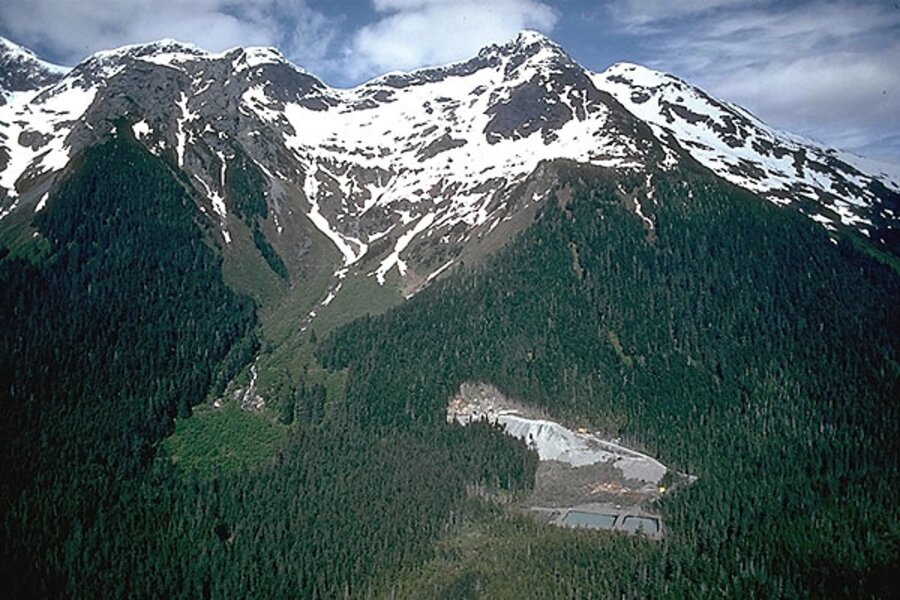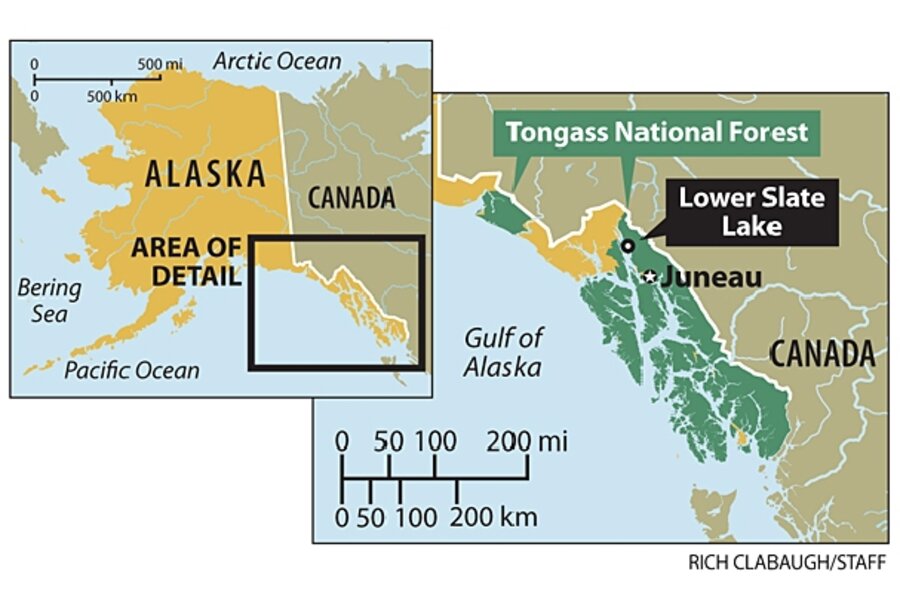Alaskan lake’s fate could echo across continent
Loading...
Roger William, a soft-spoken former chief of the Tsilhqot’in Nation in Canada, and Tim Bristol, a recreational fishing activist in the United States, have never met. They adhere to divergent cultural customs in different countries on opposite sides of rugged, glacier-sheathed mountains. But they share a common concern about the persistence of clean, untainted water and how it is becoming an ever-rarer commodity in the world.
Uniting their attention is a landmark legal case now before the US Supreme Court. Both men say the fate of faraway Lower Slate Lake, a tiny unremarkable tarn in the coastal Alaskan rainforest above the Pacific Ocean, holds huge implications for lakes across the continent.
The question soon to be answered by America’s highest court is this: Should natural lakes be used as dumping grounds for wastes generated by hardrock mines?
Nearly four decades after Congress passed the federal Clean Water Act to protect waterways from industrial pollution, the proposal by Coeur d’Alene Mines Corp. to dispose of tons of effluent in Lower Slate has sparked an international debate.
Legal scholars say it assumes a bigger profile in these tough economic times and amid soaring gold prices, yet the issue, they say, transcends the localized dichotomy of jobs versus environment.
Coeur’s blueprint for the underground Kensington gold mine located in the Tongass National Forest 45 miles north of Alaska’s capital, Juneau, was made possible by regulatory changes implemented during the Bush administration in 2002, enabling companies to use lakes as lower-cost tailings impoundments.
The action deepened a fracture line between environmentalists and industry. Moreover, it casts a spotlight on two federal regulators: the US Army Corps of Engineers, which gave Coeur the green light, and the US Environmental Protection Agency, which is accused of violating its own standards.
Environmental attorney Tom Waldo with the firm Earthjustice says that the impetus for the Clean Water Act was a legacy of contamination and public health concerns caused by industrial companies, municipalities, and agriculture historically treating waterways as convenient, expendable repositories for waste.
He points to a benchmark ruling during the 1970s against the Reserve Mining Co. in Minnesota, which disposed of taconite tailings, laden with asbestos, into Lake Superior from its processing facility, contaminating drinking water. In the US West, water quality in an estimated 40 percent of rivers has been impaired by historic mining sites long abandoned.
“The lesson is that it’s not a good idea to discharge mining wastes, especially those that are hardly benign, directly into water bodies,” Mr. Waldo explains, echoing what he said before the Supreme Court justices in January (Coeur Alaska, Inc. v. Southeast Alaska Conservation Council). Coeur, meanwhile, argued that entombing tailings in Lower Slate would actually result in a smaller development footprint over the alternative of stacking crushed earth in a remote wetland. A decision is expected before June.
“I don’t want to get into the elements of the Supreme Court case except to say we were fully permitted and ready to go ahead,” Coeur spokesman Tony Embersole says. “The only thing that hadn’t been completed was the tailings facility at the lake, then environmentalists tied it up in litigation.”
Native Alaskans support mine jobs
Among the mine’s strongest supporters, he says, are native Alaskans, including the Tlingit and Haida tribes, which have struggled with high unemployment.
“This is ... a huge economic opportunity for southeast Alaska,” Embersole says, mentioning 225 direct mining jobs, nearly as many jobs created as a byproduct of the mine, and millions of dollars in annual economic activity over the estimated 15-year life of the project.
With $220 million already invested in preparing Kensington for operation, Embersole would not say how a negative ruling from Washington, D.C., might affect the project.
A compromise brokered by the mayor of Juneau among environmentalists, the company, and federal regulators – and which would have allowed the mine to stack tailings in a wetland instead of in the lake – broke down last fall when Coeur pulled out of negotiations.
“We are not blanketly opposed to mining or to creating good jobs,” says Rob Cadmus with the Southeast Alaska Conservation Council. “There was a win-win option on the table that would have ensured the opening of the mine and the protection of the lake. Instead, Coeur decided to stick with their plan to dump wastes into Slate Lake and gamble the Supreme Court will decide in their favor.”
Coeur case may set precedent
It is this element that makes Kensington a high-stakes test case being closely watched across the continent.
Where William and Mr. Bristol are concerned, they say the Supreme Court ruling, expected later this spring, will set a precedent rippling all the way to Appalachian coal country and into the Canadian Maritimes.
For William, a parallel clash is playing out over a proposed mine in his own backyard in northern British Columbia. In his native tongue, the tarn he is trying to protect is Teztan Biny. The English translation is “Fish Lake."
Vancouver-based Taseko Mines Limited wants to use Fish Lake as a dumping ground for toxic wastes from its Prosperity Mine, a proposed multibillion-dollar open-pit gold and copper operation that would create 500 full-time jobs, 1,280 indirect jobs, and generate $200 million annually over two decades.
Mr. William recently was lead plaintiff in a case brought before the British Columbia Supreme Court that reaffirmed hunting and fishing rights for native tribes in the area where the mine is proposed.
“My people find it kind of ironic that the British Columbian government has been forced to recognize our historic claim and right to harvest fish, while at the same time it is considering granting permission to a mining company to destroy the lake where the fish live,” William says.
Taseko acknowledges that its activities will exact an ecological toll on Fish Lake. In exchange, the company says it will build an artificial body of water nearby and stock it with fish.
“The logic of it is insulting,” William responds. “Who is opposed to jobs? Not me. But as archaeologists have confirmed, our people have lived off the fish in Teztan Biny for thousands of years. The mining company wants us to sacrifice our heritage for an economic opportunity that will last 25 years and then leave us to deal with a ruined lake and worries about pollution for generations.”
Geographically speaking, mining companies aspiring to use lakes and rivers as dumping zones is a phenomenon happening coast to coast, says
Ramsey Hart with MiningWatch Canada. He ticks off the names of projects already in operation and others proposed in Labrador, Newfoundland, the Arctic north, and British Columbia. Many of them, he says, pit powerful mining companies against native tribes that allegedly were not consulted by provincial governments granting ore-diggers access to their aboriginal land, another fulcrum for growing conflict.
“Prosperity Mine is the poster child for controversy over mine wastes in lakes,” Hart says, “but, to some degree, regulators in Canada will be taking a cue from how the Kensington case is decided. I’m not so naive to think it will cause our provincial and federal governments to change their ways, but the message coming from the US will be undeniable.”
Conflict over definitions, toxicity
The law firm Ecojustice Canada filed an amicus brief with the US Supreme Court detailing impacts on lakes harmed by companies north of the US border.
Gov. Sarah Palin (R) of Alaska stands firmly behind Coeur’s proposal at Kensington. Coeur and the Army Corps of Engineers characterize the postmining material that would line the bottom of Lower Slate Lake as “fill” that is no more threatening than laying beach sand.
Waldo, the environmental attorney, says that’s misleading. “They would be taking pulverized rock from the mine, adding chemicals to help skim off the gold, then piping the leftover slurry waste over three miles to the lake at the rate of 200,000 gallons a day,” Waldo says. “This stuff won’t be harmless. It’ll have a pH level equal to ammonia, which is toxic to aquatic life.”
Steve Borell of the Alaska Miners Association claims environmentalists are callous toward people who want to make a living on natural resources.
“Their purpose is to stop any and all industrial activity,” he says. “They make Lower Slate seem like some incredible jewel. It’s just a dumb little lake that hardly has any value.”
Lower Slate is not a destination for anglers or hikers, nor is it a direct water source for humans, but it is home to an estimated 1,000 Dolly Varden char. The company acknowledges that the lake’s aquatic life, including many of those fish, will perish, though it says the lake can be restocked with new fish afterward and insists Lower Slate will end up being healthier than before.
Ruling may affect other mine projects
The US Supreme Court’s impending ruling on the impounding of mine wastes in Lower Slate Lake may set a precedent for similar situations. Among them:
• Ecojustice Canada will go before the Supreme Court of Canada to challenge the legality of the Red Chris Mine in British Columbia. Red Chris, owned by Imperial Metals Corp. of Vancouver, has proposed building a massive open-pit gold and silver operation in the middle of the Stikine River basin.
The project is estimated to generate nearly half a billion tons of tailings and waste rock that could create acid mine drainage and pose a threat to fish and wildlife deemed important to aboriginal subsistence. It has sparked protests and civil disobedience among First Nations tribes.
• The US Supreme Court ruling could also influence the direction of the largest proposed gold, copper, and molybdenum venture in the world, the Pebble Mine, being pursued on the remote Alaska Peninsula.
To extract an estimated $350 billion in minerals, Northern Dynasty Mines Inc. and its British partners, Rio Tinto and Anglo American, would open two mines: A giant open pit, and probably a network of underground tunnels, would be carved into a labyrinth of headwaters draining into Bristol Bay on the ocean and in the vicinity of lakes Clark and Iliamna.
Bristol Bay, Alaska, is at the epicenter of the largest healthy salmon runs left in the world and a legendary sport trout fishery. Gov. Sarah Palin (R) of Alaska (who supports the Kensington mine proposal) has not yet expressed publicly whether she supports the Pebble Mine venture.







